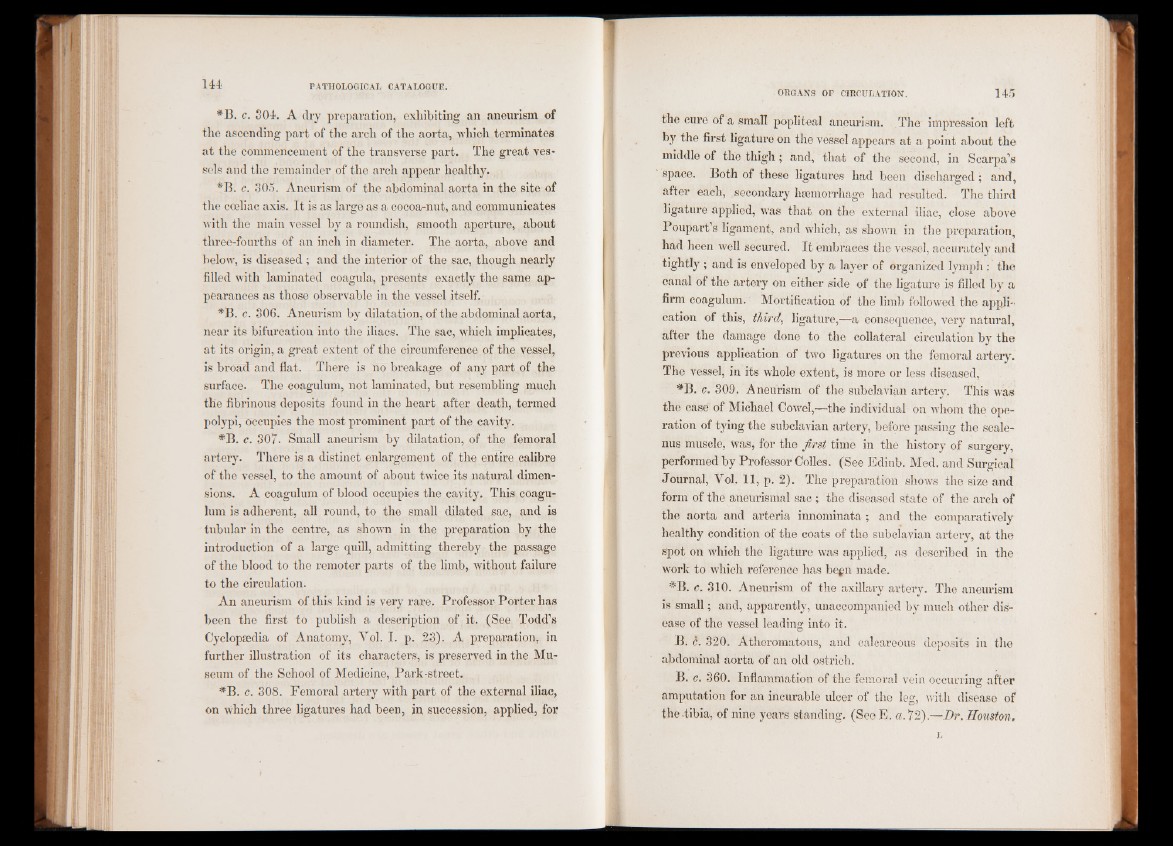
*B. c. 304. A dry preparation, exhibiting an aneurism of
the ascending part of the arch of the aorta, which terminates
at the commencement of the transverse part. The great vessels
and the remainder of the arch appear healthy.
*B. c. 305. Aneurism of the abdominal aorta in the site of
the coeliac axis. It is as large as a cocoa-nut, and communicates
with the main vessel by a roundish, smooth aperture, about
three-fourths of an inch in diameter. The aorta, above and
below, is diseased ; and the interior of the sac, though nearly
filled with laminated coagula, presents exactly the same appearances
as those observable in the vessel itself,
*B. c. 306. Aneurism by dilatation, of the abdominal aorta,
near its bifurcation into the iliacs. The sac, which implicates,
at its origin, a great extent of the circumference of the vessel,
is broad and flat. There is no breakage of any part of the
surface. The coagulum, not laminated, but resembling much
the fibrinous deposits found in the heart after death, termed
polypi, occupies the most prominent part of the cavity.
*B. c. 307. Small aneurism by dilatation, of the femoral
artery. There is a distinct enlargement of the entire calibre
of the vessel, to the amount of about twice its natural dimensions.
A coagulum of blood occupies the cavity. This coagulum
is adherent, all round, to the small dilated sac, and is
tubular in the centre, as shown in the preparation by the
introduction of a large quill, admitting thereby the passage
of the blood to the remoter parts of the limb, without failure
to the circulation.
An aneurism of this kind is very rare. Professor Porter has
been the first to publish a description of it. (See Todd’s
Cyclopaedia of Anatomy, Vol. I. p. 23). A preparation, in
further illustration of its characters, is preserved in the Museum
of the School of Medicine, Park-street.
*B. c. 308. Femoral artery with part of the external iliac,
on which three ligatures had been, in, succession, applied, for
the cure of a small popliteal aneurism. The impression left
by the first ligature on the vessel appears at a point about the
middle of the thigh; and, that of the second, in Scarpa’s
space. Both of these ligatures had been discharged; and,
after each, secondary haemorrhage had resulted. The third
ligature applied, was that on the external iliac, close above
Poupart’s ligament, and which, as shown in the preparation,
had heen well secured. It embraces the vessel, accurately and
tightly ; and is enveloped by a layer of organized lymph: the
canal of the artery on either side of the ligature is filled by a
firm coagulum. Mortification of the limb followed the application
of this, third, ligature,—a consequence, very natural,
after the damage done to the collateral circulation by the
previous application of two ligatures on the femoral artery.
The vessel, in its whole extent, is more or less diseased,
*B. c. 309. Aneurism of the subclavian artery. This was
the case of Michael Cowel,—the individual on whom the operation
of tying the subclavian artery, before passing the scalenus
muscle, was, for the first time in the history of surgery,
performed by Professor Colies. (See Edinb. Med. and Surgical
Journal, Vol. 1 1 , p. 2). The preparation shows the size and
form of the aneurismal sac ; the diseased state of the arch of
the aorta and arteria innominata; and the comparatively
healthy condition of the coats of the subclavian artery, at the
spot on which the ligature was applied, as described in the
work to which reference has be^n made.
*B. c. 310. Aneurism of the axillary artery. The aneurism
is small; and, apparently, unaccompanied by much other disease
of the vessel leading into it.
B. c. 320. Atheromatous, and calcareous deposits in the
abdominal aorta of an old ostrich.
B. c. 360. Inflammation of the femoral vein occurring after
amputation for an incurable ulcer of the leg, with disease of
the-tibia, of nine years standing. (See E. a. 72).—Dr. Houston,
L